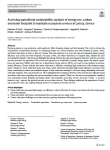Platis D.P., Menexes G.C., Anagnostopoulos C.D., Tsaboula A.D., Kalburtji K.L., Mamolos A.P. (2025). Assessing agricultural sustainability: analysis of energy use, carbon and water footprint to maintain ecosystem services in Larissa, Greece. Energy, Ecology and Environment, 01/10/2025, vol. 10, n. 5, p. 607-622.
https://doi.org/10.1007/s40974-025-00374-8
https://doi.org/10.1007/s40974-025-00374-8
| Titre : | Assessing agricultural sustainability: analysis of energy use, carbon and water footprint to maintain ecosystem services in Larissa, Greece (2025) |
| Auteurs : | D.P. Platis ; G.C. Menexes ; C.D. Anagnostopoulos ; A.D. Tsaboula ; K.L. Kalburtji ; A.P. Mamolos |
| Type de document : | Article |
| Dans : | Energy, Ecology and Environment (vol. 10, n. 5, October 2025) |
| Article en page(s) : | p. 607-622 |
| Langues : | Anglais |
| Langues du résumé : | Anglais |
| Catégories : |
Catégories principales 07 - ENVIRONNEMENT ; 7.4 - Ressources Naturelles : Paysage, Biodiversité, Patrimoine naturelThésaurus IAMM AGRICULTURE ; DURABILITE ; CONSOMMATION D'ENERGIE ; EMPREINTE HYDRIQUE ; BILAN CARBONE ; SERVICE ECOSYSTEMIQUE ; GRECE |
| Résumé : | Resource-intensive crop production could negatively affect changing climate and food demand. This study evaluates the sustainability of agricultural practices by examining energy use, carbon footprint, and water footprint in maize, cotton, and wheat cultivations in Larissa, Thessaly, Greece. The main objective is to assess the agri-environmental indices (energy efficiency and carbon and water footprints) of maize, cotton, and wheat cultivations to compare them, identify the most environmental friendly cultivation and highlight the linkage between the agri-environmental indicators and the ecosystem services provided. An agricultural life cycle-based approach was conducted to quantify energy inputs and outputs, greenhouse gas emissions (GHG), and water use. A hierarchical cluster analysis (HCA) was used to reveal patterns in environmental efficiency. Results indicate that maize cultivation is efficient, combining high productivity with moderate energy inputs. Despite its lower yield than maize and cotton, wheat cultivation presented high energy efficiency and lower blue water, contributing to reduce environmental impact. Cotton cultivation emerged as the most energy demanding cultivation, with high irrigation, fuel, and pesticide use. HCA highlighted the divergence between cotton and the more efficient maize and wheat cultivations regarding the agri-environmental indices applied. Wheat was the most environmentally beneficial crop concerning carbon footprint and energy inputs, that maintains ecosystem services provision. Cotton-a resource intensive crop-imposes the greatest pressure on ecosystem services. These findings emphasize the importance of selecting sustainable crops and adapting farming practices to maintain ecosystem services. |
| Cote : | En ligne |
| URL / DOI : | https://doi.org/10.1007/s40974-025-00374-8 |







